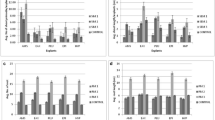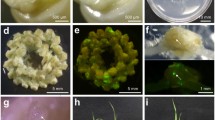Abstract
The present study was designed to establish embryogenic callus as a target tissue for whisker-mediated transformation of maize (Zea mays L.). Silicon carbide whiskers were used to deliver the bar and uidA (GUS) genes into embryogenic maize callus. Samples of osmotically-treated Type II callus were vigorously agitated in the presence of whiskers and plasmid DNA using a standard laboratory vortex or a modified dental amalgamator. On average, three transgenic callus lines were obtained per 100 samples treated. Plants were regenerated from several GUS-expressing callus lines and DNA analyses confirmed stable integration and inheritance. As with other direct DNA delivery methods involving embryogenic maize callus, integration patterns of the inserted DNA appeared to be complex. Although currently less efficient than microparticle bombardment on a per target basis, whisker-mediated transformation of embryogenic callus represents a viable method for transgenic maize production.
Similar content being viewed by others
Author information
Authors and Affiliations
Additional information
Received: 14 May 1999 / Revision received: 11 October 1999 / Accepted: 11 October 1999
Rights and permissions
About this article
Cite this article
Petolino, J., Hopkins, N., Kosegi, B. et al. Whisker-mediated transformation of embryogenic callus of maize. Plant Cell Reports 19, 781–786 (2000). https://doi.org/10.1007/s002999900180
Issue Date:
DOI: https://doi.org/10.1007/s002999900180




